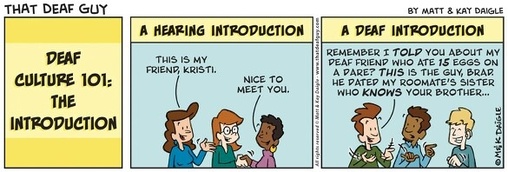Many hearing people are shocked to find out that not only do Deaf people have their own language, but they also have their own culture that is unique to the Deaf experience.
Deaf culture refers to the unique cultural characteristics, norms, values, language, and traditions shared by individuals who are Deaf or hard of hearing.
It is important to understand that being Deaf or hard of hearing is not a disability in the same sense as a medical condition; instead, it is often seen as a difference in communication and sensory perception.
Deaf culture is not exclusive to one specific group or community, as it encompasses a diverse range of people who identify as Deaf, DeafBlind, hard of hearing, and more.
Signed Languages
Many individuals within Deaf Culture take pride in their language.
It is a common misconception that signed languages are just a signed version of the native spoken language. Sign languages are fully developed languages with their own grammar and syntax.
Deaf culture often revolves around the use of sign language as a primary means of communication.
While Deaf and hard of hearing individuals are the most common users of American Sign Language, there are many other communities who also use ASL or other signed communication methods. There is also a very large community of high school students and college students taking American Sign Language in schools.
ASL is number three most popular languages to learn in the United States.
Commission of the Deaf and Hard of Hearing
Deaf Identity
Many individuals who are Deaf or hard of hearing have a strong sense of identity tied to their Deafness.
They do not see their Deafness as a disability and instead see it as part of what makes them unique.
They often take pride in being part of the Deaf community and may refer to themselves as Deaf with a capital “D” to emphasize their cultural identity.
Why is the Deaf Community important for Deaf people?
Deaf individuals often share common experiences related to communication challenges, navigating a predominantly hearing world, and experiencing discrimination or misunderstanding due to their deafness.
These shared experiences contribute to a sense of community. Despite being labeled as disability, the Deaf community stands on its own with the language, culture, common grounds and identity.
There are other groups of people besides Deaf individuals that will sometimes identify as part of the Deaf community.
A few of the more common groups include:
- CODAs (Children of Deaf Adults)
- GODAs (Grandchildren of Deaf Adults)
- Interpreters
- Hard of hearing individuals
- Cochlear Implant users
- Parents of Deaf Children
How to Get Involved in the Deaf Community
The best way to get involved in the Deaf community and culture is to attend Deaf events and gatherings. Deaf culture has always included the rich tradition of gatherings, events, and social activities, such as Deaf clubs, Deaf schools, Deaf sports, and Deaf theater.
These events provide opportunities for deaf individuals to come together, share experiences, and celebrate their culture.
Some examples of Deaf events to attend include:
- Theatre performances like National Association of the Deaf or Deaf West Theater.
- Local Deaf Club.
- Deaf Awareness Month (September) celebrations.
- Your local communities Deaf Night Out.
- Deaf festivals.
You can start learning about Deaf culture from home through Deaf artistic expression. Some common forms of Deaf artistic expression include Deaf literature, visual arts, and performances that often reflect the experiences and perspectives of the deaf community.
Some examples of Deaf artistic expression to check out are:
It’s important to note that not all individuals who are Deaf or hard of hearing identify with or participate in Deaf culture.
Some may choose to integrate more with the hearing world and may not use sign language as their primary mode of communication. Deaf culture is diverse, and individuals within it may have different experiences and perspectives.
Frequently Asked Questions
If you’re still curious about Deaf Culture, continue reading.
What are the four components of Deaf Culture?
The four components of Deaf Culture are language, behavioral norms, values, and traditions.
How do I politely get someone’s attention in Deaf Culture?
The best way to get someone’s attention in Deaf Culture would be to wave your hand. Waving your hand is the most common custom. Other ways to get a Deaf person’s attention include flicking the lights, stomping on the ground, tapping on their shoulder, or texting them.
What not to do when talking to a Deaf person
If you don’t know ASL, here are some things not to do if you find yourself communicating with a Deaf person:
- Don’t cover your mouth when talking.
- Don’t start talking without being aware of your surroundings. Is it loud where you are? Can you move some place quieter? Is there bad lighting? Can you move somewhere where they can read your lips better?
- Don’t continue repeating yourself using the same exact words.
- Don’t shout or exaggerate your mouth patterns.
- Don’t give up.








Comments